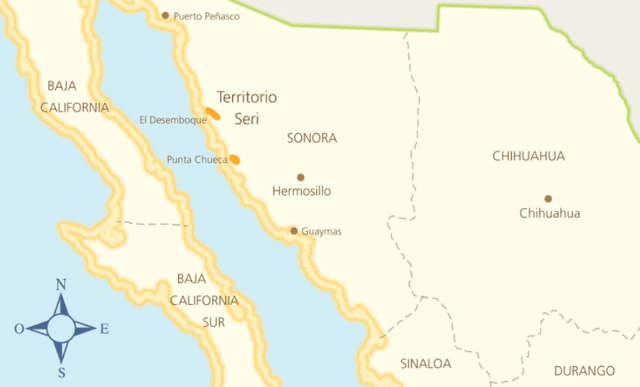Symbolism, art, and craftsmanship of the Comcáac or Seri
For centuries, the Seri or Comcáac, an indigenous people who have lived by hunting and fishing in the desert coast of Sonora, have made a living from their handicrafts.

The Comcáac or Seris are an indigenous people with a population of close to a thousand individuals, whose cultural roots extend through the same coastal desert they have inhabited for centuries: living between the sea and the desert; between abundance and austerity, as marked by the cycles of nature that they, in their own way, managed to understand long ago.
In the Comcaac/Seri world, acaiix refers to a pair of lance-shaped tablets, finely carved from ironwood. One end has an almost pointed edge and the other a rounded or straight edge. A perforation is made in the latter, through which a strap is passed, made of mesquite root fiber or any other resistant material. When a tablet is tied at each end of the rope, this beautiful and enigmatic piece is almost complete, it only takes a few knowledgeable hands to take it between their fingers, and at the right place and time begin to spin the tablets.
The person who spins them and makes them hum intones some special chants with which, according to tradition, if everything is done well, one can obtain what is expected: to make the spirits that occupy some cave or rest inside a large basket come out; to invoke the powers of the sea or the desert and obtain from them their power. In Spanish, these objects are called roncadores or zumbadores and, no matter what language is spoken, the sound they make as they cut the air traps...
In one place in my house, I have my acaiix, and they remind me of the symbolic complexity that manifests itself in art and craft, expressions of the thought and vitality of an ancestral yet contemporary society: that of those who call themselves comcáac ("the people"), but who have been historically known, by outsiders, as the Seris (a term considered to be of Yaqui origin and supposed to mean "those who live in the sand").
Welcome to Hant Comcáac
On the desert coast of Sonora, one hundred and twenty kilometers from Hermosillo, the state capital, lies Hant Comcáac, the Seri territory, which extends along the seashore between the municipalities of Hermosillo and Pitiquito; in front of them, crossing Xeepe Cosot (the Infiernillo Channel), lies Taeöj, the island of the Shark, a bastion of identity and ethnic resistance of this society, whose history is still not fully understood. The members of the Comcaac nation, who speak Qmique Iitom (Seri language), a unique language, live primarily in two communities: Socaiix (Punta Chueca), in the municipality of Hermosillo, and Axöl Ihöm (El Desemboque), in Pitiquito.
This is a society that through the centuries has managed to conserve fundamental aspects of their way of thinking and way of life; the latter has been based substantially on three economic activities: hunting, fishing, and gathering. The interesting thing is that despite the attempts of domination and assimilation by Spaniards and Mexicans, and the transformations in their territory and traditions, especially throughout the 20th century, today the Comcáac continue to depend on these activities, only in very different ways, in accordance with the demands of the present time, which gives them their character as a contemporary society.
Hunting has been a fundamental activity for the Comcaac. In ancient times, they used long and slender bows with which they shot arrows, which since the time of the conquest were feared and recognized for their lethality; it is known that they also used small boomerang-type weapons, with which they trapped smaller animals. Bighorn sheep, deer, and hares were some of their main hunting prey and formed an important part of their diet. With the passage of time and the adoption of new technologies, rifles replaced the old bows, and are now made only as a reminder of those old days.
Today, through new work models and respecting environmental conservation, the Comcáac have a program of controlled hunting of bighorn sheep, which involves different certifications and norms; in this way, through legal auctions, permits are obtained that authorize expert hunters from various parts of the world to try to capture prey. The resources thus obtained are used to cover expenses, permits, and certifications; in addition, they cover operating expenses and the salary of a group of para-ecologists, who are specialists from the Comcáac nation itself in the care and monitoring of the bighorn sheep population.
At the end of the process, and after expenses have been deducted, the remaining money from the program is managed by a trust fund, to which community members have the right to request support for health care and cultural conservation programs. This experience has yet to be consolidated, but it shows us one way in which society can respond to existing needs.
Since time immemorial, the sea has been a source of life for the Comcáac/Seri; fishing has provided them with food and materials to make different objects. Thus, spines, shells, shells, snails, and other pieces from the bodies of mollusks, chelonians and brachiopods have served as instruments or ornaments.
As far as fishing is concerned, this has been a fundamental activity in the life of the Comcaac, which in its origin was a navigating culture; capable of taking advantage of the resources of the desert regions, and also with a deep knowledge of the sea and the life of the species that live in it, which is observed in their songs and their knowledge of navigation. It is believed that long ago, the Comcaac arrived at what is now Sonora's territory crossing the Gulf of California in boats made of reeds; and in several migrations, they settled in the coastal desert territories.
Fishing was mainly done with harpoons, and sea turtles were one of the most prized prey; that is why they were associated with a symbolism that is still preserved to this day, in which the seven-edged turtle stands out, to which some Comcaac attribute the origin of the world and to which a very special and important ceremony is dedicated, celebrated when a fisherman captures a leatherback turtle. With the passage of time, the old reed rafts were replaced by wooden boats, and still, in the 1950s it was possible to see the Seris sailing.
Today, fishing is done in fiberglass pangas (boats) with outboard motors and diving, using a wide range of fishing gear (nets, traps); in addition, indigenous fishermen now compete in the state and regional seafood market. There is also an association of young ecologists known as Grupo Tortuguero, which works on conservation and monitoring programs for the different species of mossnii (sea turtles) found in the territory. This group has made recommendations to local fishermen to modify the type of nets they use so as not to put the turtles at risk, which has been generally well accepted.
Since time immemorial, the Comcaac have been a people who know how to enter the sea and take advantage of its resources. They combined the techniques of the fisherman and the hunter using the harpoon as their main fishing tool.
As a particular note we should mention that in addition to the para-ecologists linked to the protection and hunting of the bighorn sheep and the Grupo Tortuguero, there are also other working groups that monitor the populations of birds, coyotes, and many other species, as well as taking care of the natural resources of the desert: the small and scarce forests of ironwood, mesquites and Mexican greenwood (palo verde), or the ocotillos and saguaros. The area that reaches the sea itself, which configures Xeepe Cosot (the Infiernillo Channel), is eventually guarded by elements of the traditional Seri guard, who protect their territory and resources, as they are frequent victims of plundering by poachers, among other problems.
Hunting and fishing have been transformed among the Comcáac and the way in which conservation actions have been derived from these appropriation activities, in which ancestral knowledge about nature's resources and their better use and conservation is recognized. In other words, the same activities are carried out as before, but from a different perspective and based on the recognition of our own knowledge and what we now understand as biocultural heritage. This process has been a long journey, not an easy one, and in which, in certain stages of history, war and discrimination were the only policies in force to deal with the Seri. Fortunately, the extermination attempt failed and they are still here.
Artists and artisans amidst the sands of time
The third axis on which the life of the Comcaac has been based is the activity of gathering everything that is useful for their existence, and that serves as food or to make tools, utensils, weapons, and clothing. In their cosmovision, everything is expressed in the materiality of things and they are given an identity in their use and manufacture.

One of the first tasks that the ancestors of the current Comcaac had to carry out was the recognition of the resources available to them in their new territory on the desert coast of Sonora, to which they arrived from the islands of the Gulf of California; the similarity with the territory of the Baja California peninsula was the basis of their knowledge, but there was much to learn over the generations. Among the knowledge generated, the use of xnoiis (sea wheat) made from the seeds of a certain aquatic plant (Zoostera marina) stands out, as well as other marine and desert resources. Many and diverse living beings integrated the diet of the comcáac or were used for diverse purposes.
They navigated in rafts and wandered through the desert, and it was thus that seeds, roots, leaves, flowers, fruits, stems, and branches of plants; as well as several animal species and a great number of natural resources were known, by observation and experimentation, and the essence of the knowledge of the Comcaac about their territory and its resources was little by little decanted, and at the same time the knowledge of the cycles of nature, of production and reproduction of the living beings that inhabit there grew. This set of learning is transformed into the creation and constant recreation of culture, in which the identity of a living and contemporary society is being configured.
The Comcaac/Seri women have participated in the activities of gathering wild products and making handicrafts, while the men have been hunters and fishermen.
Today, harvesting is still present in the lives of those who live in houses built on the sand, facing the sea, and from where Taeöjj, the mythical and real Shark Island, can be contemplated.
An important part of the collection is related to the handicraft activity, in which the symbolism is expressed and that acquires particular life in the hands of each craftswoman and each Comcáac artisan. What we know today as Seri crafts, or Comcaac crafts, is the result of a long and intense process of expression that manifests the cosmovision of this society and confronts it with market reality and forms of exchange, with commercial piracy and the theft of its tradition, with ecological and economic problems, but that in spite of everything manifests a beautifully natural and very human aesthetic, if the expression fits, without mere apologetic eagerness.
Comítin (making an ironwood figure)
Undoubtedly, one of the most recognized and important crafts of the Comcáac universe has long been the carving of figures in czaxoj or palo fierro (Olneya tesota). These are sculptures that essentialize the forms and movement of sea and desert species, such as reptiles, birds, and snails, and also the sun and the moon or human figures are part of the essential repertoire that has acquired thousands of forms in each hand-carved piece, and that for more than fifty years has spread beyond the territory of the Comcáac thanks to occasional buyers, dedicated collectors or eventual traders.
An important Comcaac character, Don José Astorga, is the mythical founder of this artisan tradition. In the last years of his life, he narrated a story in which he explained the magical origin of the ironwood carving: During a journey to bed ("in spirit"), he detached himself from his body and traveled far from his land, carried by giants to a place where he heard songs he remembered from his childhood. From this mysterious journey, he returned with new knowledge about how to carve hardwood. Little by little, his art conquered the hearts of the people, and his words became a message and teaching, acquired the form of myth, and gave meaning to tradition; as powerful were his dreams as his words, and his example still persists in the hands of the many Comcaac artisans and sculptors who carve wood or stone and, in their own way, bring them to life.
A problem that indigenous artisans have had to face for several decades is the plagiarism of this artistic expression because since the seventies of the twentieth century began to grow the industry of ironwood carving with electric machinery, made by new non-indigenous artisans, who initially found in this activity an alternative to meet their own basic economic needs but then have been dedicated to this production for unbridled profit.
This has had a tremendous impact on the population of the ancestral ironwood trees because while the Comcaac artists used only the dry wood of fallen trees, the industrial artisans cut live trees with electric saws. The custom of making charcoal from ironwood contributes to further diminishing this species. As a result of the plundering of the wood, the Comcaac artists began to carve miniature figures and also to sculpt in stone, thus transferring their aesthetic conception to new materials, but conserving the philosophy that gives meaning to their work: to unveil the inner spirit of each piece of wood or rock.
The reed rafts made it possible for the ancestors of today's Comcaac to navigate the Gulf of Baja California. Today, outboard motorboats have relegated these rafts to museum pieces.
Before ironwood sculpture, the soft woods, such as torote, were a pretext for carving certain figures, the icommolca, small bifacial forms with a human silhouette, which are a kind of saint. Since ancient times, these figures were placed at the entrance of the hacoaemmza (ocotillo houses) as protection, to ward off powerful spirits that could invade the houses, dragged by the wind or perhaps attracted by bad thoughts, which were to be annulled with the power of the chants. When the wind blows, the icommolca turn like a weather vane. Thus, the artisan tradition of carving and sculpting in soft wood has its origins in the magical and symbolic thinking of the Comcaac, as well as in the search for protection for their homes and families. From this intention, the expression overflows into sculptures, which also give rise to one-stringed violins, with which spiritual songs and dances are accompanied in the mythical time of the Comcaac.
It was in the 1950s that the transformation of this practice began to take shape and sculptures in ironwood, polished with shoe polish, took shape. This process, mythical and real, has to do with the encounter of cultures, and above all with the exchange between the Comcaac and the Americans, who little by little began to recognize this territory and admire its ancestral culture, which also has a contemporary character. In the beginning, only a few artisans stood out, and then, little by little, a great number of them were surprised with their aesthetic capacity. A family way of working was developed: some members look for wood and carve, others give the final finish and others are in charge of the sale. Soon after, their craftsmanship was copied, but the connoisseur distinguishes the best qualities of the original work and, above all, its aesthetic conception.
Some artisans prefer to work with bones, antlers, fangs, sea lion teeth, eagle claws or hawksbill plates, pearls or shells to make northern stars, rings, bracelets, necklaces, all made from the remains of sea and desert animals, without ever threatening their lives. In the process of this work, families unite and organize, their members support the artisans, and the sale of their work is a help, sometimes slow but continuous, for daily maintenance. But it also represents the need for aesthetic expression of a society that lives in front of the sea and next to the desert, from which it acquires its vision of things and its vigorous aesthetic expression.
Author: Alejandro Aguilar Zeleny, Professor-researcher at the National Institute of Anthropology and History in Sonora. Source: Correodelmaestro.com




